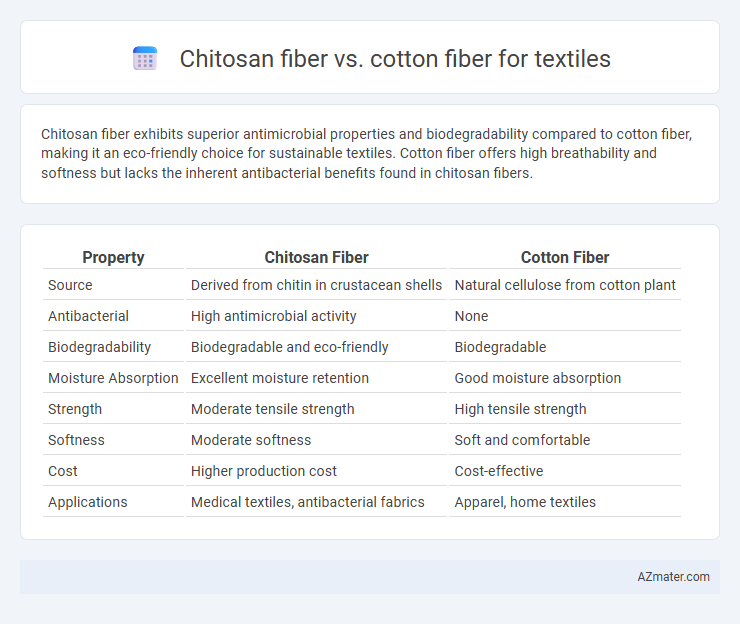Chitosan fiber exhibits superior antimicrobial properties and biodegradability compared to cotton fiber, making it an eco-friendly choice for sustainable textiles. Cotton fiber offers high breathability and softness but lacks the inherent antibacterial benefits found in chitosan fibers.
Table of Comparison
| Property | Chitosan Fiber | Cotton Fiber |
|---|---|---|
| Source | Derived from chitin in crustacean shells | Natural cellulose from cotton plant |
| Antibacterial | High antimicrobial activity | None |
| Biodegradability | Biodegradable and eco-friendly | Biodegradable |
| Moisture Absorption | Excellent moisture retention | Good moisture absorption |
| Strength | Moderate tensile strength | High tensile strength |
| Softness | Moderate softness | Soft and comfortable |
| Cost | Higher production cost | Cost-effective |
| Applications | Medical textiles, antibacterial fabrics | Apparel, home textiles |
Introduction to Chitosan and Cotton Fibers
Chitosan fiber, derived from chitin found in crustacean shells, offers biodegradability, antimicrobial properties, and moisture retention, making it a sustainable alternative in textiles. Cotton fiber, sourced from the seed hairs of the cotton plant, is renowned for its softness, breathability, and durability, widely used in fashion and home textiles. Both fibers present unique functional benefits, with chitosan fibers enhancing textile hygiene and cotton fibers emphasizing comfort and traditional versatility.
Origins and Sources of Chitosan and Cotton
Chitosan fiber is derived from chitin, a natural polysaccharide found in the exoskeletons of crustaceans such as shrimp, crabs, and lobsters, making it a sustainable byproduct of the seafood industry. Cotton fiber originates from the seed hairs of the cotton plant, Gossypium species, cultivated primarily in warm climates across countries like India, China, and the United States. The renewable marine source of chitosan contrasts with the agricultural crop-based origin of cotton, influencing their environmental impact and production processes in textile manufacturing.
Production Processes: Chitosan Fiber vs Cotton Fiber
Chitosan fiber production involves extracting chitosan from crustacean shells, followed by dissolving and spinning it into fibers using wet or dry spinning methods, which require specialized chemical treatments and controlled environments. Cotton fiber production begins with harvesting cotton bolls, followed by ginning to separate fibers from seeds, then carding and spinning processes that are predominantly mechanical and well-established in the textile industry. Compared to cotton, chitosan fiber production demands more advanced bio-based chemical processing techniques, impacting scalability and environmental considerations.
Chemical and Physical Properties Comparison
Chitosan fiber exhibits superior antimicrobial and moisture-wicking properties compared to cotton fiber, thanks to its unique amino groups that enhance antibacterial activity and water absorption. Chemically, chitosan fibers are biodegradable polysaccharides with inherent biocompatibility, whereas cotton fibers are primarily cellulose-based with higher hydrophilicity but limited antimicrobial effects. Physically, chitosan fibers offer greater tensile strength and elasticity, while cotton fibers provide softness and breathability essential for comfort in textile applications.
Biodegradability and Environmental Impact
Chitosan fiber offers superior biodegradability compared to cotton fiber, breaking down faster in natural environments due to its biopolymer structure derived from chitin, a renewable source from crustacean shells. This rapid decomposition significantly reduces textile waste accumulation and lowers environmental pollution, making chitosan fiber an eco-friendly alternative in sustainable textile production. Cotton cultivation requires substantial water, pesticides, and land resources, contributing to environmental degradation, whereas chitosan fiber production leverages waste materials and minimizes ecological footprint.
Comfort and Wearability in Textiles
Chitosan fiber offers superior moisture absorption and antibacterial properties, enhancing comfort by keeping the skin dry and reducing odors compared to traditional cotton fiber. Its natural biodegradability and softness contribute to a lightweight, breathable textile that maintains wearability in various conditions. Cotton fiber, while breathable and widely used for comfort, lacks inherent antimicrobial features and retains more moisture, which can affect overall wearability during extended use.
Antimicrobial and Hypoallergenic Properties
Chitosan fiber exhibits superior antimicrobial properties compared to cotton fiber due to its natural ability to inhibit bacterial growth and prevent odor formation, making it ideal for hygiene-sensitive textile applications. It also provides hypoallergenic benefits by reducing skin irritation and allergic reactions, unlike cotton which can sometimes retain allergens and irritants. The biodegradable and biocompatible nature of chitosan enhances its appeal in sustainable and health-conscious textile manufacturing.
Cost-Effectiveness and Market Availability
Chitosan fiber offers enhanced antimicrobial properties and biodegradability, making it a premium choice in specialized textiles but typically comes at a higher cost compared to conventional cotton fiber. Cotton fiber remains widely available and cost-effective due to established farming, processing infrastructure, and large-scale production, driving its dominance in the global textile market. Limited production and higher raw material expenses restrict chitosan fiber's market availability, making it suitable primarily for niche applications where functional benefits justify the investment.
Applications in Fashion and Medical Textiles
Chitosan fiber offers superior antimicrobial properties compared to cotton fiber, making it highly suitable for medical textiles such as wound dressings and hospital garments that require infection control. In fashion applications, chitosan fiber provides enhanced moisture absorption and odor resistance, which improves comfort and hygiene in activewear and intimate apparel. Cotton fiber remains favored for its natural softness, breathability, and cost-effectiveness, maintaining dominance in casual and everyday clothing despite lacking the advanced biofunctional benefits of chitosan.
Future Trends and Innovations in Fiber Technology
Chitosan fiber, derived from chitin in crustacean shells, offers promising antibacterial, biodegradable, and moisture-retentive properties compared to traditional cotton fiber, which remains highly breathable and comfortable. Emerging innovations in fiber technology focus on enhancing chitosan fiber's durability and blending capabilities to create eco-friendly textiles with superior performance for activewear and medical fabrics. Future trends emphasize sustainable production methods and integrating nanotechnology to further improve functionality and reduce environmental impact in both chitosan and cotton fiber textiles.

Infographic: Chitosan fiber vs Cotton fiber for Textile
 azmater.com
azmater.com